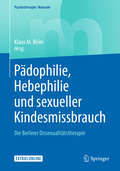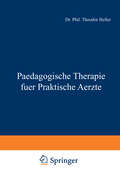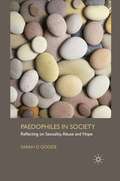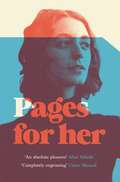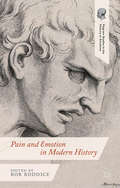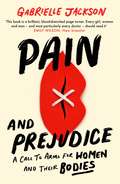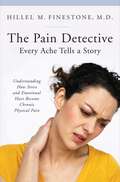- Table View
- List View
Pädagogisches Rollenspiel: Wissensbaustein und Leitfaden für die psychosoziale Praxis (essentials)
by Manfred GüntherManfred Günther beschreibt in diesem essential eindrucksvoll das Pädagogische Rollenspiel. Er zeigt, wie dieses in den 1970er-Jahren als ein neues, angeleitetes Methodenangebot entstanden ist. Das Pädagogische Rollenspiel entwickelte sich als ein VT-fundiertes Vorhaben, das praktisch eingesetzt großen Spaß macht und das dabei mühelos im pädagogischen Sinn erwünschte Kompetenzen übertragen kann. Denn beim Spiel geht es kulturübergreifend häufig um das Einüben von wichtigen sozialen Fähigkeiten oder auch um Aufarbeitung von Themen oder Konflikten.
Pädophilie, Hebephilie und sexueller Kindesmissbrauch: Die Berliner Dissexualitätstherapie (Psychotherapie: Manuale)
by Klaus M. Beier„Lieben Sie Kinder mehr als Ihnen lieb ist?“ Mit diesem Slogan bietet das Präventionsprojekt Dunkelfeld seit 2005 Menschen, die sich sexuell zu Kindern hingezogen fühlen, diagnostische und therapeutische Unterstützung, um sexuellen Kindesmissbrauch zu verhindern. Das vorliegende Buch informiert ausführlich über Pädophilie (d.h. die sexuelle Ansprechbarkeit für das kindliche Körperschema), Hebephilie (d.h. die sexuelle Ansprechbarkeit für das frühpubertäre Körperschema) und über die Prävention sexueller Traumatisierungen von Kindern und Jugendlichen.
Paedagogische Therapie fuer Praktische Aerzte: Allgemeiner Teil (Enzyklopaedie der Klinischen Medizin)
by Theodor HellerDieser Buchtitel ist Teil des Digitalisierungsprojekts Springer Book Archives mit Publikationen, die seit den Anfängen des Verlags von 1842 erschienen sind. Der Verlag stellt mit diesem Archiv Quellen für die historische wie auch die disziplingeschichtliche Forschung zur Verfügung, die jeweils im historischen Kontext betrachtet werden müssen. Dieser Titel erschien in der Zeit vor 1945 und wird daher in seiner zeittypischen politisch-ideologischen Ausrichtung vom Verlag nicht beworben.
Paediatric Gastrointestinal Disorders: A Psychosocial Perspective
by Clarissa MartinThe medical specialty of paediatric gastroenterology is focused on problems and disorders within the gastrointestinal tract, liver and pancreas of children from infancy until age eighteen. This inspirational compilation provides information on current research and clinical practice regarding the psychosocial aspects of paediatric gastrointestinal c
Paediatric Gastrointestinal Disorders: A Psychosocial Perspective
by Clarissa MartinThe medical specialty of paediatric gastroenterology is focused on problems and disorders within the gastrointestinal tract, liver and pancreas of children from infancy until age eighteen. This inspirational compilation provides information on current research and clinical practice regarding the psychosocial aspects of paediatric gastrointestinal c
Paediatric Neurosurgery for Nurses: Evidence-based care for children and their families
by Joanna Smith Catherine MartinPaediatric Neurosurgery for Nurses: Evidence-based care for children and their families provides accessible and up-to-date information for nurses working in paediatric neurosurgery. Referring throughout to the evidence-base for care and interventions, this complex area is described and explained in a meaningful and easily understandable way. The text includes chapters on the underpinning knowledge and principles for the care of children who need neurosurgery as well as the following common neurological problems: Hydrocephalus Traumatic Brain Injury Craniosynostosis Brain Tumours Surgical management of epilepsy in children Cerebrovascular disorders Neural tube defects The complexity of the nervous system and principles of care are presented logically with points to consider and essential care clearly highlighted and, where available, evidence-based practice is presented. It includes a range of pedagogical features, such as chapter overviews and summaries, diagrams, sample care plans, text boxes and a glossary. This book is essential reading for pre-registration nursing students and newly qualified nurses but will also be of use to allied healthcare professionals working with children and young people requiring neurosurgery.
Paediatric Neurosurgery for Nurses: Evidence-based care for children and their families
by Joanna Smith Catherine MartinPaediatric Neurosurgery for Nurses: Evidence-based care for children and their families provides accessible and up-to-date information for nurses working in paediatric neurosurgery. Referring throughout to the evidence-base for care and interventions, this complex area is described and explained in a meaningful and easily understandable way. The text includes chapters on the underpinning knowledge and principles for the care of children who need neurosurgery as well as the following common neurological problems: Hydrocephalus Traumatic Brain Injury Craniosynostosis Brain Tumours Surgical management of epilepsy in children Cerebrovascular disorders Neural tube defects The complexity of the nervous system and principles of care are presented logically with points to consider and essential care clearly highlighted and, where available, evidence-based practice is presented. It includes a range of pedagogical features, such as chapter overviews and summaries, diagrams, sample care plans, text boxes and a glossary. This book is essential reading for pre-registration nursing students and newly qualified nurses but will also be of use to allied healthcare professionals working with children and young people requiring neurosurgery.
Paediatrics, Psychiatry and Psychoanalysis: Through counter-transference to case management
by Adrian SuttonHow do children and parents shape clinical practice? How can clinicians learn from the impact of their patients upon them? How do we recognise if health care practices are adversely affecting health care? Children's health problems can place enormous strain on both children and their families. Whether symptoms are acute or chronic, assessment and treatment can be confusing and frightening even when the illness itself is not dangerous. Understanding the impact of illness on emotions, relationships and development is an essential part of providing good health care services. For health care professionals it is necessary to understand how their clinical practice affects their patients and how this reciprocal relationship shapes good or bad practice. Introducing key psychoanalytic concepts Adrian Sutton illustrates through detailed clinical studies how psychoanalytic theory can be applied in a health care setting involving children and their families. Paediatrics, Psychiatry and Psychoanalysis specifically describes the impact of the patient on the professional, how conscious and unconscious elements need to be taken into account, and to what extent these can influence practice enhancing diagnostic and therapeutic treatment. Paediatrics, Psychiatry and Psychoanalysis is an exploration of the central importance of the patient-doctor relationship and how the psychodynamics of this relationship are crucial in providing information that can aid treatment. It will be of interest to child mental health professionals – psychoanalysts, psychotherapists, psychiatrists, psychologists, nurses, paediatric practitioners and those working in social welfare and educational settings.
Paediatrics, Psychiatry and Psychoanalysis: Through counter-transference to case management
by Adrian SuttonHow do children and parents shape clinical practice? How can clinicians learn from the impact of their patients upon them? How do we recognise if health care practices are adversely affecting health care? Children's health problems can place enormous strain on both children and their families. Whether symptoms are acute or chronic, assessment and treatment can be confusing and frightening even when the illness itself is not dangerous. Understanding the impact of illness on emotions, relationships and development is an essential part of providing good health care services. For health care professionals it is necessary to understand how their clinical practice affects their patients and how this reciprocal relationship shapes good or bad practice. Introducing key psychoanalytic concepts Adrian Sutton illustrates through detailed clinical studies how psychoanalytic theory can be applied in a health care setting involving children and their families. Paediatrics, Psychiatry and Psychoanalysis specifically describes the impact of the patient on the professional, how conscious and unconscious elements need to be taken into account, and to what extent these can influence practice enhancing diagnostic and therapeutic treatment. Paediatrics, Psychiatry and Psychoanalysis is an exploration of the central importance of the patient-doctor relationship and how the psychodynamics of this relationship are crucial in providing information that can aid treatment. It will be of interest to child mental health professionals – psychoanalysts, psychotherapists, psychiatrists, psychologists, nurses, paediatric practitioners and those working in social welfare and educational settings.
Paedophiles in Society: Reflecting on Sexuality, Abuse and Hope
by S. GoodeBased on original research with self-identified paedophiles in the community, this book challenges assumptions and destroys the sacred cows of both radical and conservative thinking on paedophilia and sexuality. Offering a humane and inspiring vision, the book goes beyond previous thinking to develop an inclusive new approach.
Pages for Her: A Novel
by Sylvia Brownrigg'A complex portrait of two women's sexuality . . . an absolute pleasure' Alice SeboldFlannery, a writer with one well-known rather racy book to her name, is, by her own admission, in a situation she never thought she'd be: married to a man who overshadows her and defined by her primary relationships as wife and mother. When Flannery is invited to a writers' conference she sees a chance to return to a world she knew well. And then she recognizes the name of the chair of the event: Anne Arden. Suddenly Flannery is thrown back twenty years to her eighteen-year-old self and the most intense love affair of her entire life. On the other side of the world Anne is travelling for work. Recently out of a decades-long partnership, she feels adrift, unsettled. When a friend asks her to chair an event at a writers' conference she says yes and a couple of months later, on the same campus where they met and fell in love, Anne and Flannery are reunited. Though their lives have taken them in different and unexpected directions, the pull between them proves irresistible. Elegant, clever, witty and sensual, Sylvia Brownrigg's Pages for Her is a novel about love, memory and what it is to be a woman, a wife, and a mother.
Pain (UK Higher Education OUP Psychology Psychology)
by Sandra Horn Marcus MunafoWhat explanations have been advanced for pain and and what are their shortcomings?How do theoretical models account for apparent anomalies in the experience of pain? What are the implications for clinical practice and how has practice guided theory?Psychology has made an enormous contribution to the understanding of pain and its phenomena, mechanisms, and treatments. This book explores and integrates current research in key areas of pain and pain management from a psychological perspective, and places recent developments in an historical context.The experience of pain cannot be captured in physiological terms, and treatments based on physical models are often inadequate. This book explores the multidimensional nature of pain mechanisms, including the roles of past experience, culture and personality, and considers the implications for research and treatment. The approach is primarily theoretical, but with a significant emphasis on clinical practice and application. This balance is often lacking in comparable texts, and is enhanced by the professional and research background of the authors.This clear and approachable text includes self-contained chapters that can be regarded as units of study and a unified glossary of terms completes the package. It is designed to provide a key resource for advanced undergraduate and postgraduate courses in health psychology, clinical psychology and social psychology as well as students and practitioners in health and social welfare.
Pain: A Medical and Anthropological Challenge Proceedings of the First Convention of the Academia Eurasiana Neurochirurgica Bonn, September 25–28, 1985 (Acta Neurochirurgica Supplement #38)
by Jean Brihaye, Fritz Loew and H. W. PiaThe First Convention of the Academia Eurasiana Neurochirurgica was devoted to one of the main problems not only of medicine in general and especially of neurosurgery but also of theology and anthropology. Many of these aspects have been discussed. Experts in the fields of biological and neurosciences, representatives of different religions and philosophers have contributed to a better un derstanding of the somatic aspects of pain and its medical treatment and of its religious, cultural, and philosophical interpretations and interactions. It really was a unique event to bring together scientists and physicians, priests, theologians and philosophers, make them give reviews of their fields and have them discussing the many facets of pain and suffering. To achieve such a difficult goal was mainly the achievement of the late Hans Werner Pia, the first President of the Academia Eurasiana Neurochirurgica and organizer of this Convention. Because the Convention is inseparably related to the Inauguration of the Academia Eurasiana Neurochirurgica the speeches and lectures given on this occasion and dealing with the aim of the Academia, the founding of Academies in history and with the anthropological challenge of pain are also published in this Supplement Volume of Acta Neurochirurgica. The Convention and the Inauguration of the Academia Eurasiana Neurochirurgica are a fitting memorial to the personality of Hans Werner Pia. Its proceedings are dedicated to him.
Pain and Emotion in Modern History (Palgrave Studies in the History of Emotions)
by Robert Gregory BoddiceDrawing on the expertise of historical, literary and philosophical scholarship, practicing physicians, and the medical humanities this is a true interdisciplinary collaboration, styled as a history. It explores pain at the intersection of the living, suffering body, and the discursive cultural webs that entangle it in its specific moment.
Pain and Its Relief Without Addiction: Clinical Issues in the Use of Opioids and Other Analgesics
by Barry StimmelPain and Its Relief Without Addiction will help people in pain understand why their pain is not always adequately relieved, as well as help reverse the failure of current medical practice to routinely alleviate pain. As noted by a 1992 publication of the United States Department of Health Services, this devastating trend contributes to unnecessary discomfort, longer recovery periods, and compromised patient outcomes. By reading this book, frustrated physicians and, perhaps more importantly, persons in pain can acquire a better understanding of the nature of pain, its connection to the emotions and psychological state of patients, and the impact particular drugs have on the body; this will facilitate relief from pain among a higher percentage of the population.Opioid analgesics comprise many of the chapters in Pain and Its Relief Without Addiction. Author Barry Stimmel, MD, describes the principles to be followed in prescribing opioid analgesics to relieve pain while maintaining one’s daily activities without any limitation in function. The available opioids are described, and the differences between them are reviewed to allow you--as a physician, health care provider, or even a patient--to gain a better insight into the one(s) to use for both acute and chronic pain states. The point that is emphasized is that dependency on an analgesic to relieve pain is no different than dependency on medications to lower blood pressure, prevent heart attacks, treat diabetes, etc. What should be avoided is “addiction,” a condition where function is impaired rather than enhanced.Pain and Its Relief Without Addiction is a guidebook designed to assist physicians and other health professionals in developing a practical approach to pain management and to give patients a fuller understanding of their pain. You’ll gain specific information about: management of acute and chronic pain pain in children pain and cancer pain and AIDS psychological support of persons in pain theories of pain perception the anatomy of painIn Pain and Its Relief Without Addiction, you’ll learn the basic concepts of drug dependence, tolerance, and withdrawal, the pharmacological actions and side effects of drugs used to provide analgesia, and the fundamental steps to be taken in proper pharmacological treatment of pain. The book produces more effective and more informed communication among physicians, other health professionals, and patients so that together they can achieve better pain relief. As Pain and Its Relief Without Addiction illustrates, it is crucial that both patients and physicians understand clearly the terms describing drug use and the behavioral, biochemical, and cellular concepts underlying dependence, tolerance, and withdrawal. Finally, you will acquire a knowledge of all the potential causes of pain and the appropriate steps for intervention.Medical students, new practitioners, and those wishing to reconsider their approaches to pain management will benefit from the book’s coverage of general principles for pain control, the use of drug combinations to provide the most effective relief, methods for treating pain in different populations (such as the elderly and persons with chronic medical conditions), and alternative options for failed treatment. The scope of Pain and Its Relief Without Addiction reaches from nonprescription medications, such as aspirin, to NSAIDS, like ibuprofen, to narcotic analgesics to stimulants such as amphetamines and caffeine. It is the most comprehensive book available on various drugs, their desired effects and side effects, and their use to alleviate pain.
Pain and Its Relief Without Addiction: Clinical Issues in the Use of Opioids and Other Analgesics
by Barry StimmelPain and Its Relief Without Addiction will help people in pain understand why their pain is not always adequately relieved, as well as help reverse the failure of current medical practice to routinely alleviate pain. As noted by a 1992 publication of the United States Department of Health Services, this devastating trend contributes to unnecessary discomfort, longer recovery periods, and compromised patient outcomes. By reading this book, frustrated physicians and, perhaps more importantly, persons in pain can acquire a better understanding of the nature of pain, its connection to the emotions and psychological state of patients, and the impact particular drugs have on the body; this will facilitate relief from pain among a higher percentage of the population.Opioid analgesics comprise many of the chapters in Pain and Its Relief Without Addiction. Author Barry Stimmel, MD, describes the principles to be followed in prescribing opioid analgesics to relieve pain while maintaining one’s daily activities without any limitation in function. The available opioids are described, and the differences between them are reviewed to allow you--as a physician, health care provider, or even a patient--to gain a better insight into the one(s) to use for both acute and chronic pain states. The point that is emphasized is that dependency on an analgesic to relieve pain is no different than dependency on medications to lower blood pressure, prevent heart attacks, treat diabetes, etc. What should be avoided is “addiction,” a condition where function is impaired rather than enhanced.Pain and Its Relief Without Addiction is a guidebook designed to assist physicians and other health professionals in developing a practical approach to pain management and to give patients a fuller understanding of their pain. You’ll gain specific information about: management of acute and chronic pain pain in children pain and cancer pain and AIDS psychological support of persons in pain theories of pain perception the anatomy of painIn Pain and Its Relief Without Addiction, you’ll learn the basic concepts of drug dependence, tolerance, and withdrawal, the pharmacological actions and side effects of drugs used to provide analgesia, and the fundamental steps to be taken in proper pharmacological treatment of pain. The book produces more effective and more informed communication among physicians, other health professionals, and patients so that together they can achieve better pain relief. As Pain and Its Relief Without Addiction illustrates, it is crucial that both patients and physicians understand clearly the terms describing drug use and the behavioral, biochemical, and cellular concepts underlying dependence, tolerance, and withdrawal. Finally, you will acquire a knowledge of all the potential causes of pain and the appropriate steps for intervention.Medical students, new practitioners, and those wishing to reconsider their approaches to pain management will benefit from the book’s coverage of general principles for pain control, the use of drug combinations to provide the most effective relief, methods for treating pain in different populations (such as the elderly and persons with chronic medical conditions), and alternative options for failed treatment. The scope of Pain and Its Relief Without Addiction reaches from nonprescription medications, such as aspirin, to NSAIDS, like ibuprofen, to narcotic analgesics to stimulants such as amphetamines and caffeine. It is the most comprehensive book available on various drugs, their desired effects and side effects, and their use to alleviate pain.
Pain and Prejudice: A call to arms for women and their bodies
by Gabrielle JacksonAn incredibly important and powerful look at how our culture treats the pain and suffering of women in medical and social contexts. A polemic on the state of women's health and healthcare.One in ten women worldwide have endometriosis, yet it is funded at 5% of the rate of diabetes; women are half as likely to be treated for a heart attack as men and twice as likely to die six months after discharge; over half of women who are eventually diagnosed with an autoimmune disease will be told they are hypochondriacs or have a mental illness. These are just a few of the shocking statistics explored in this book.Fourteen years after being diagnosed with endometriosis, Gabrielle Jackson couldn't believe how little had changed in the treatment and knowledge of the disease. In 2015, her personal story kick-started a worldwide investigation into the disease by the Guardian; thousands of women got in touch to tell their own stories and many more read and shared the material. What began as one issue led Jackson to explore how women - historically and through to the present day - are under-served by the systems that should keep them happy, healthy and informed about their bodies.Pain and Prejudice is a vital testament to how social taboos and medical ignorance keep women sick and in anguish. The stark reality is that women's pain is not taken as seriously as men's. Women are more likely to be disbelieved and denied treatment than men, even though women are far more likely to be suffering from chronic pain.In a potent blend of polemic and memoir, Jackson confronts the private concerns and questions women face regarding their health and medical treatment. Pain and Prejudice, finally, explains how we got here, and where we need to go next.
Pain and Touch (Handbook Of Perception And Cognition)
by Morton P. Friedman Edward C. CarteretteAn explosion of advances in the area of tactile perception and pain led to the development of this comprehensive, state-of-the-art text on basic research and clinical practice. Equal parts psychology and neuroscience, Pain and Touch covers peripheral cutaneous tactile information processing, sensory mapping, tactile exploratory behavior, neurophysiology of nociception and nociceptors in pain research, clinical scaling methods for psychophysics of pain, and paincontrol, pathology, and therapeutics.
The Pain Detective, Every Ache Tells a Story: Understanding How Stress and Emotional Hurt Become Chronic Physical Pain (The Praeger Series on Contemporary Health and Living)
by Hillel M. FinestoneSure to be welcomed by the thousands suffering persistent pain, this volume explores what physicians often ignore—how psychological and social issues can influence health, illness, pain, and recovery."Pain is everywhere and everyone is talking about it," says Dr. Hillel Finestone, M.D., a researcher and rehabilitation specialist whose work has been featured in publications as diverse as The Lancet, and USA Today. The key to understanding causes and solutions for many apparently mysterious, recurring aches, he explains, lies in understanding the mind-body relationship and the "real meaning" behind symptoms with no immediately obvious cause.Taking the reader into several diagnostic sessions to illustrate what he sees as a "detective" process to find the source of pain, Finestone explains how psychological and social issues can influence health and healing, for better or worse. Low back and neck pain, fibromyalgia and even work related pains are delved into.In addition to vignettes that illustrate the ideas discussed and show dramatic incidences of how healing the mind can also heal the body, Finestone uses unique and useful diagrams which explain how mind and body are physiologically connected and reactive to each other. In these pages, readers can follow Dr, Finestone through patient sessions and understand, step by step, how the "pain detective" works to help his patients—and perhaps his readers, too—find lasting relief.
Pain, Emotion and Cognition: A Complex Nexus
by Gisèle Pickering Stephen GibsonThis book focuses on the reciprocal interactions between pain, emotion and cognition. International experts report on their findings, clinical experience and the most recent literature on the complex relations between these three domains. Clinical, psychological, behavioral and neuroimaging approaches converge towards aiding patients suffering from pain, cognitive impairment or emotional distress.Beyond the pathophysiological aspects of pain, difficulties encountered with patients are analyzed and strategies are proposed to optimize treatment, doctor-patient relationships, and patient well-being.This work will appeal to a broad readership, from clinical medical practitioners to psychologists, nurses and pain specialists.
Pain Medicine: An Essential Review (Pocket Notebook Ser.)
by R. Jason Yong Michael Nguyen Ehren Nelson Richard D. UrmanThis book serves as a practical resource for pain medicine providers. It presents important clinical concepts while covering critical pain medicine fundamentals. Chapters were carefully chosen to cover common aspects of clinical pain medicine and also follow a common format to facilitate quick look-up. Each chapter includes a concise discussion of the latest supporting evidence as well as relevant case scenarios. The coverage is clinically and board relevant, evidence-based and up-to-date. It will appeal to residents preparing for the written board examination and practitioners preparing for board re-certification, which now occurs every 10 years. Beyond these groups, the book has the potential to appeal to learners and practitioners around the world; pain medicine is burgeoning globally, and there is great need for concise, clinically relevant resources.
Pain, Normality, and the Struggle for Congruence: Reinterpreting Residential Care for Children and Youth
by James P AnglinLearn what children living in group homes need most! Pain, Normality, and the Struggle for Congruence: Reinterpreting Residential Care for Children and Youth presents the results of a 14-month study of 10 staffed group homes in British Columbia. The book uses grounded theory to construct a theoretical model that speaks to the primary challenge care workers face each day-responding to pain and pain-based behavior in residents. It combines participant observations, transcribed interviews, and document analysis to develop a core theme of congruence, several major psychosocial processes, and 11 interactional dynamics identified as being fundamental to group home life. The study brings to light several neglected aspects of residential care and proposes new directions in policy development, education, practice, and research to create an integrated and accessible framework for understanding group home life for youths. Pain, Normality, and the Struggle for Congruence: Reinterpreting Residential Care for Children and Youth is a full and rigorous examination of the theoretical and empirical underpinnings of residential group care. The study-conducted during a time of heightened sensitivity to the rights of children and increased emphasis on accountability and outcome measurement-reveals a core theme of congruence, focusing on consistency, reciprocity, and coherence. The book examines the major elements of this theme, including: creating an extra-familial living environment developing a sense of normality listening and responding with respect establishing a structure, routine, and expectations offering emotional and developmental support respecting personal space and time discovering potential communicating a framework for understanding and much more! Pain, Normality, and the Struggle for Congruence: Reinterpreting Residential Care for Children and Youth provides professionals concerned with the development and treatment of children and young people with a unique understanding of group home life and work. From the Foreword, by Dr. Barney Glaser: I am honored and delighted to be asked by Jim Anglin to write the foreword to this grounded theory text... The purpose of this grounded theory is to construct a theoretical framework that would explain and account for well-functioning staffed group homes for young people, that in turn could serve as a basis for improved practice, policy development, education and training, research, and evaluation. THE READER WILL SEE THAT ANGLIN HAS ACHIEVED HIS GOAL WITH ADMIRABLE SUCCESS. . . . HIS GROUNDED THEORY TRULY MAKES A SCHOLARLY CONTRIBUTION TO THE LITERATURE.
Pain, Normality, and the Struggle for Congruence: Reinterpreting Residential Care for Children and Youth
by James P AnglinLearn what children living in group homes need most! Pain, Normality, and the Struggle for Congruence: Reinterpreting Residential Care for Children and Youth presents the results of a 14-month study of 10 staffed group homes in British Columbia. The book uses grounded theory to construct a theoretical model that speaks to the primary challenge care workers face each day-responding to pain and pain-based behavior in residents. It combines participant observations, transcribed interviews, and document analysis to develop a core theme of congruence, several major psychosocial processes, and 11 interactional dynamics identified as being fundamental to group home life. The study brings to light several neglected aspects of residential care and proposes new directions in policy development, education, practice, and research to create an integrated and accessible framework for understanding group home life for youths. Pain, Normality, and the Struggle for Congruence: Reinterpreting Residential Care for Children and Youth is a full and rigorous examination of the theoretical and empirical underpinnings of residential group care. The study-conducted during a time of heightened sensitivity to the rights of children and increased emphasis on accountability and outcome measurement-reveals a core theme of congruence, focusing on consistency, reciprocity, and coherence. The book examines the major elements of this theme, including: creating an extra-familial living environment developing a sense of normality listening and responding with respect establishing a structure, routine, and expectations offering emotional and developmental support respecting personal space and time discovering potential communicating a framework for understanding and much more! Pain, Normality, and the Struggle for Congruence: Reinterpreting Residential Care for Children and Youth provides professionals concerned with the development and treatment of children and young people with a unique understanding of group home life and work. From the Foreword, by Dr. Barney Glaser: I am honored and delighted to be asked by Jim Anglin to write the foreword to this grounded theory text... The purpose of this grounded theory is to construct a theoretical framework that would explain and account for well-functioning staffed group homes for young people, that in turn could serve as a basis for improved practice, policy development, education and training, research, and evaluation. THE READER WILL SEE THAT ANGLIN HAS ACHIEVED HIS GOAL WITH ADMIRABLE SUCCESS. . . . HIS GROUNDED THEORY TRULY MAKES A SCHOLARLY CONTRIBUTION TO THE LITERATURE.
The Pain of Helping: Psychological Injury of Helping Professionals (Psychosocial Stress Series)
by Patrick J. MorrissetteThe purpose of The Pain of Helping is to provide a source that identifies, condenses, and consolidates information pertaining to psychological injury. In addition to providing details regarding construct definition, information pertaining to symptomatology, assessment instruments (e.g. structured interview, questionnaires), treatment options, leading theoreticians, journals, books, and web sites are also included. This book will serve as a primary source and directory for additional information pertaining to psychological injury. To date, there has not been a concerted effort to synthesize and consolidate the literature of psychological injury and present this valuable information in a systematic and methodological fashion.
The Pain of Helping: Psychological Injury of Helping Professionals (Psychosocial Stress Series)
by Patrick J. MorrissetteThe purpose of The Pain of Helping is to provide a source that identifies, condenses, and consolidates information pertaining to psychological injury. In addition to providing details regarding construct definition, information pertaining to symptomatology, assessment instruments (e.g. structured interview, questionnaires), treatment options, leading theoreticians, journals, books, and web sites are also included. This book will serve as a primary source and directory for additional information pertaining to psychological injury. To date, there has not been a concerted effort to synthesize and consolidate the literature of psychological injury and present this valuable information in a systematic and methodological fashion.

